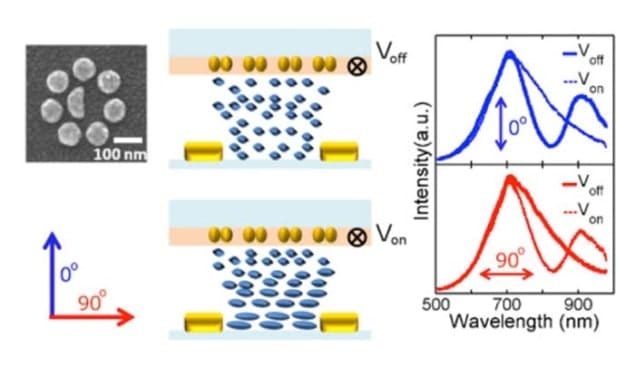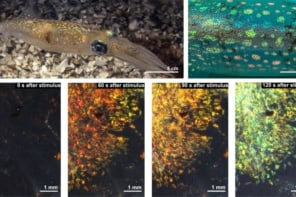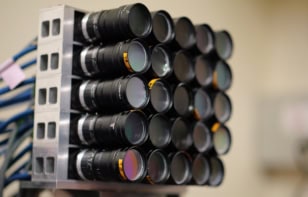
Researchers in the US have created the first “plasmonic Fano switch” made from tiny gold nanoparticles and liquid crystals. The device might be used as an active filter that reflects/transmits light of a certain wavelength and would be ideal in applications such as colour displays because it is more stable than traditionally employed organic chromophores.
Nanoplasmonics is a new and upcoming field of research that focuses on using metallic nanostructures to make tiny optoelectronics devices. Tiny metallic structures show great promise because they interact strongly with light via localized surface plasmons, which are collective oscillations of electrons on a metal’s surface.
The plasmonic Fano switch was developed by a team led by Naomi Halas and Stephan Link at Rice University in Texas. The device consists of a specifically designed cluster of gold nanoparticles fabricated using electron-beam lithography. The cluster comprises a large hemi-circular disc surrounded by seven smaller nanodiscs. Interactions between localized surface-plasmon resonances of the individual nanoparticles within a cluster lead to a so-called Fano resonance. This resonance comes about thanks to near-field coupling between collective “bright” and “dark” plasmon modes of the cluster.
Symmetry breaking
“By breaking the symmetry of the nanoparticle cluster through the hemi-circular centre disc, the Fano resonance is polarized and can only be observed for one polarization of incident light,” explains Link. As a result, no Fano resonance appears in the light spectrum, for incident light that is polarized at 90° to this direction.
The nanoparticle clusters are incorporated into liquid crystals in which the molecules at the device interface can be rotated in plane by 90° when an AC voltage of about 6 V is applied. The field creates a twist in the overall alignment direction of the crystals, which leads to a “homogenous nematic” (voltage off) to a “twisted nematic” (voltage on) phase transition.
Fano-resonance switching
“Thanks to the birefringence of the liquid crystal, the voltage-induced phase transition causes an orthogonal rotation of the scattered light from the plasmonic clusters as it travels through the device,” Link says. “This results in switching between the optical response with and without the Fano resonance, so we are thus able to switch the Fano resonance on and off in a voltage-dependent manner.” The presence or absence of Fano resonance affects how light is transmitted through the device and therefore the system could be used as an optical switch.
The device might be used as an active filter that reflects/transmits light of a certain wavelength and that could then be turned on or off by applying an external voltage, he adds. It could be ideal for use in colour displays because plasmonic nanostructures are much more stable than the organic chromophores typically employed as colour pigments today. Replacing these organic molecules, which photobleach over time, with plasmonic nanostructures could thus dramatically increase the lifetime and brightness of colour displays.
The Rice team says that it is now working on Fano-switch devices that operate at lower voltages. “We are also further optimizing the cluster geometry to manipulate the polarized Fano resonances so that we can achieve a larger contrast of the on–off modulation for a narrow spectral range,” says Link.
The current work is detailed in Nano Letters.



